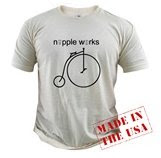First, pick your responses. These are the qualities you want to maximize, minimize, optimize. Then, pick a slew of factors. These are the things that you can adjust or choose to give you a desired outcome. Say you were a triathlete or stage race cyclist on a budget. Say you were a college cycling athlete for example. Or this individual, looking to improve your ride split time and add the structure and focus you so desperately need in your life through statistics and rigorous science:
 Here are some examples I thought up:
Here are some examples I thought up:Factors:
| Aerobars vs drops |
| Skinsuit vs. Road Kit |
Responses:
| Cd / Course Time |
You'd want to minimize both coefficient of drag (if you have iBike / Powertap combo or course time if you don't) and also minimze total gear cost. Total gear cost would be easy to figure out. Bust out a catalog and add up the total cost for the gear combo under test. Ideally, you'd have some statistical software to randomize the test runs and crunch the numbers like JMP or Minitab but if you're a science/enginering/business school student, you should probably be forced to figure it out using a mechanical pencil, quadrille pad and formula tables :-) The software though, would help you to spot interactions. Like, does an aero helmet make a difference if you don't have aero bars? Maybe not. The results could be very influential to all levels of competitive cyclists.
So, anyone got some free time and a desire to try this? Caltech Velo I'm looking your way...
So, anyone got some free time and a desire to try this? Caltech Velo I'm looking your way...
photo shamelessly stolen from http://www.elizabethkreutz.com/












2 comments:
I haven't had the DOE training, but it seems to me that there is an implicit assumption of linearity in the relationship between variables. In other words, if f(x,y,z) has a min at x=a when y=0, then f will still have a min at x=a when y=small, where small is some minor excursion in the value of y. If this assumption of linearity fails, the utility of DOE is limited. The problem with aerodynamics is that it is inherently non-linear, as shown by the fact that drag forces increased as velocity squared. On the other hand, frontal areas do *mostly* add to C_D. Non-linearity becomes even worse when eddies at sharp edges ("turbulence") is considered.
A trivial example of failure of linearity is that if you add a cowling to the front of the bike, messing with the placement of the rear brakes or shape of the wheel isn't going to matter much. A less trivial example is that changing the front wheel shape slightly for the better may well change the optimal brake placement.
Analysis of aero data and trends is truly difficult. Nonetheless, I've heard that NASA Ames has shut down its wind tunnel due to confidence in calculations.
I think that if a non-linear response surface is of concern, the number of center points can be increased. However, the factors I have described are all non-continuous (either aero or standard with no middle ground) so a function will not be a valid output as much as a Pareto plot would.
Post a Comment